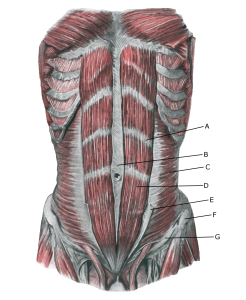Anatomy

The pelvis consists of 2 halves, joined at the back by the sacrum and at the front by the pubic symphysis. The abdominal muscles (M rectus abdominis, m. obliquus internus abdominis, m. transversus abdominis) attach to the upper edge of the pubic bone (os pubis) close to the symphysis. Several muscles, including the inward-facing muscles of the thigh (e.g. M adductor longus) attach in the groin to the front and lower part of the pubic bone.
Abdominal muscles:
A. Intersectio tendinea
B. Linea alba
C. M. transversus abdominis
D. M. rectus abdominis
E. Vagina m. recti abdominis (lamina aF. terior) (overskåren)
G. Spina iliaca anterior superior
H. Lig. inguinale
See foto of inflammation of the abdominal muscle at the point of attachment on the pubic bone
Cause
When a muscle is subjected to repeated loads that exceed the muscle strength (jumping, kicking, sit-ups), damage to the muscle occurs most frequently at the tendon attachment. The repeated overloads can result in chronic ”betændelse” (inflammation) tears that weaken the tissue.
The pain is a warning that the training is too strenuous for the muscle attachment in question, and if the load is not reduced, a rupture (“fibre”) can occur, resulting in a significantly longer rehabilitation period.
In some cases, pain in the pubic joint (symphysis) can also occur skambensleddet (symfysen). Acute injuries can lead to rupture and hemorrhage in the muscles that can pull down into the inner thigh and perineum/scrotum.
Symptoms
Pain around the abdominal muscle attachment on the pubic bone, worsening with pressure, stretching and activation of the abdominal muscles (crunches, sit-ups).
Examination
Diagnosis is usually made on clinical examination alone, with tenderness on the injured muscle and worsening on activation of the muscle against resistance (abdominal flexion). Severe cases or cases that do not improve on treatment should be assessed by a professional to ensure an accurate diagnosis.
If the examination reveals pain when pressing the muscle tendon attachment on the pubic bone and worsening in the same place when stretching and activating (abdominal flexion), there is little doubt about the diagnosis, although the diagnosis of groin pain can be extremely difficult.
In case of doubt, an X-ray, ultrasound or MRI scan can be used as a supplement.
Treatment
Treatment usually consists of relief from pain-inducing activity and graduated rehabilitation within the pain threshold. If rehabilitation is not successful, medical treatment may be considered in the form of arthritis pills, NSAID or injection of adrenal cortex hormone along the inflamed part of the muscle attachment on the pubic bone as part of a month-long rehabilitation programme to reduce the risk of recurrence.
Surgery is only indicated in very severe cases.
Complications
If the progression is not smooth, you should consider whether the diagnosis is correct
In particular, the following should be considered:
- Inflammation of the adductor of the thigh
- Inflammation of the pubic joint
- Bursitis on the front of the hip joint
- Fluid accumulation in the joint
- Degenerative arthritis
- Brupture of the superficial hip flexor
- Rupture of the deep hip flexor
- Inner snapping hip
- Fatigue fracture of the femoral neck
- Inguinal hernia
- Sportsman’s hernia
- Nerve entrapment
